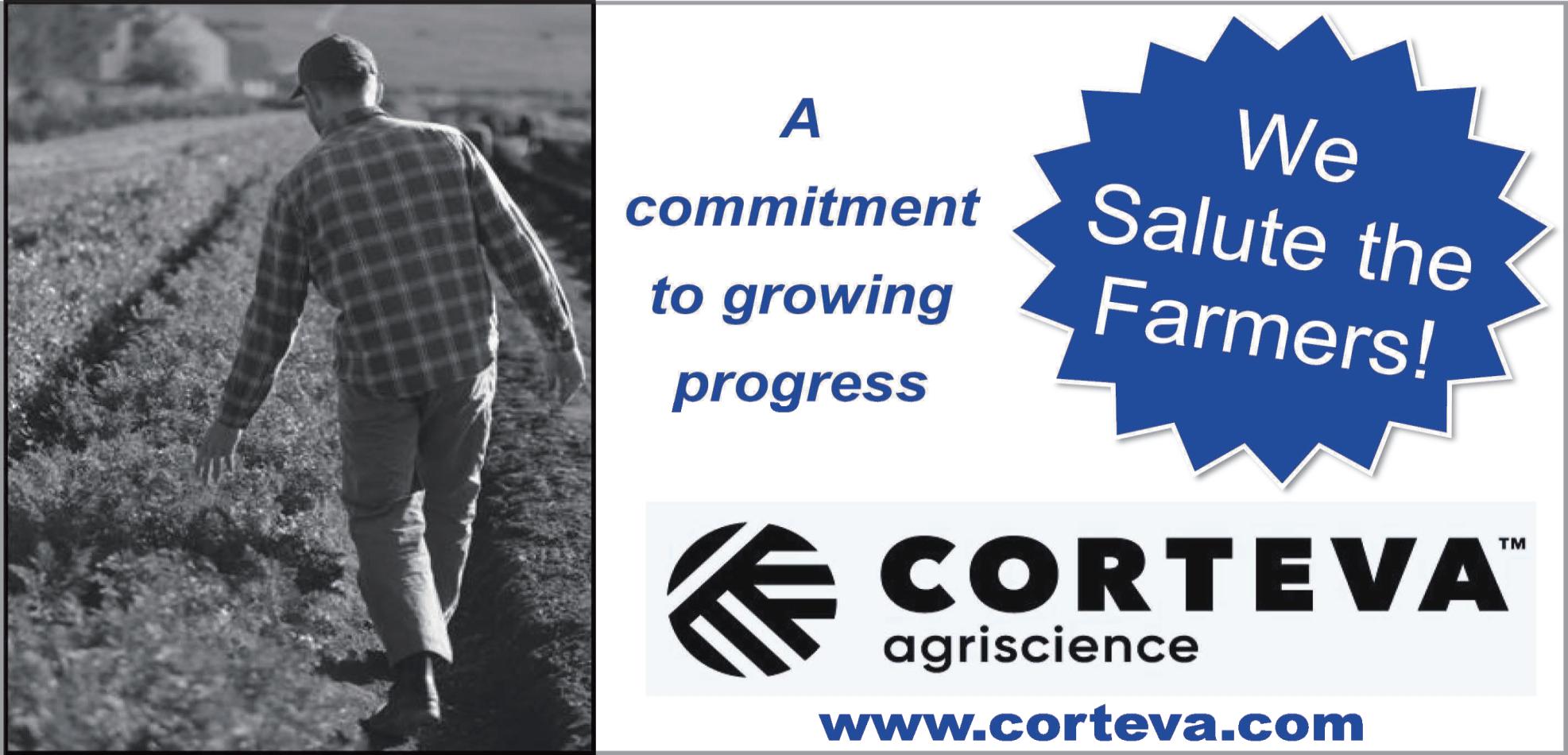
































With the growing season starting, John Creguer is preparing for another year out in the field. Having worked on a farm since he was a teenager, he is preparing for another year of growing organic crops on his farm near the Minden City area.
Creguer’s crops are a mix of different crops, with some staying in Michigan and others being exported across the Midwest and even out of the country.
Q: How long have you been a farmer?
I have formally been farming since I was 15 years old, so a little over 16 years of farming alongside my parents.
They are both still very active on the farm.
Q: As an organic farmer. what types of crops do you grow?
We grow dry edible beans, soybeans, corn, and wheat. In the past, we produced snap beans, onions, and potatoes.
Q: Why do you farm organic?
It was a system of farming that made sense to us and worked for us. My father, Pete, was one of the catalysts in organic farming on the east side of Michigan back in the early 90s. He and my mother, Jill, both grew up on conventional farms and attempted to farm the same way on the farm we are on now, but were not having any success. Yields were low, and



overall soil and crop health was poor. They adopted the organic approach, and it changed our farm for the better. Yields began to increase, soil health improved, and resiliency in our crops also improved. We never looked back after that. Just because it worked for us, doesn’t mean it will work for everyone else. I need to stress the importance of that fact.
Q: How did you prepare for this growing season?
In all honesty, we are still in preparation mode for this upcoming season. The organic markets have been quite challenging in the last couple of years. More so this year with the
new bird flu strain going through, and that is affecting the organic corn market quite heavily. We have had to make last-second changes to our planting intentions and inputs. But with that being said, it is allowing us more time to have everything absolutely ready for when we can get ready to go.
Q: What is your timeline for your crops?
We typically like to plant corn in the May 20 range. If we are planting soybeans, we are hovering around Memorial Day weekend. If we are planting dry edible beans, we follow a similar path as soybeans, or later, depending on if we intend to plant wheat in the
fall or not. We like to have wheat planted no later than Oct. 15, if possible.
Q: Where do your crops get distributed? Do they stay local? Do they go out of state?
Typically corn stays in Michigan, if not the Midwest, to either Herbruck’s, Miller Poultry or Kalambach, which are all poultry farms/feed mills. Soybeans typically go to Everbest Organics in Munger, Michigan, and from there, food-grade soybeans will be processed for tofu in the domestic and Asian markets. When we were consistently growing dry edible beans, specifically, pinto beans, we were growing for Eden Foods
in Clinton, Michigan. Those beans would be canned under the Eden Foods label. Our wheat normally goes to a flour mill in Wisconsin.
Q: Has the weather affected your schedule at all this year?
As of right now, we are on schedule, but would like to get started prepping fields no later than the first or second week of May. While the above-average precipitation for this month is throwing the timing off a little bit, we will take the moisture that we can, due to the lack of snowfall the last couple of years, we are only two to three missed rains from being in dry conditions again.

Sarah fronczak, Michigan State UniverSity extenSion - april 25, 2024
Advice for sampling and cleanout for lagoons and anaerobic digesters and safety considerations.
Sludge is the residue of biological manure treatment that accumulates in lagoons and digesters. It is lower in organic matter and higher in solids and minerals because of the longer treatment time in the manure storage structure. This also makes sludge denser than manure. Sludge has a lower odor intensity than manure.
Sludge storage in the facility reduces the treatment volume of the structure. When mixed with the liquid portion of manure, sludge can increase the nutrient content of recycled liquid pumped out of the facility. Issues with barn air quality and pathogen issues have also been noted in manure storage facilities. Finally, the high levels of zinc and copper in digester sludge can affect the microbe populations and the treatment performance.
Test the depth in multiple locations across the facility as some areas will be deeper than others. To measure sludge depth, use a weighted plate or disc with a rope attached such as a Sludge Judge type of product or an acoustic tool like a fish finder. Sludge sampling can be done with a clamshell sampler, a Sludge Judge, or other custom solutions. Send these samples off to get tested by a lab. Plan to apply the sludge to fields that show a need for the nutrients in the sludge, particularly copper, zinc and phosphorus. Expect the cost of collecting information on sludge depth and nutrients to cost around $325 per million
gallon according to a study by the University of Missouri.
In lagoons it is common to use PTO powered pumps and floating pumps or boats. Dredging and dewatering is done less often but can be used if sludge needs to travel a significant distance to be spread. Covered lagoons and digesters can be more difficult to pump out. Submerged pump-out lines with ports as well as sludge suspension and pumping are usually the best method in this situation. In some cases, partial or complete removal of the cover may be necessary. It is estimated that the cost to agitate and land apply is approximately $0.0188/gallon at a million gallons a day.
Lagoon solids removal can be tricky especially if there is a high level of solids in the sludge. This may result in the need to dilute, agitate and dilute again before pumping and land application. Finally, train employees to be safe around manure gases that can be released when agitated. Other potential hazards include PTO shafts, confined spaces and pressurized hoses.
This information is a summary of a presentation by the Livestock and Poultry Environmental Learning Center (LPELC) on January 21, 2022. If you would like to watch the videos in full you can find them here. For help with manure storage management you can contact Sarah Fronczak, Environmental Educator, with MSU Extension.
This article was published by Michigan State University Extension. For more information, visit https://extension.msu.edu. To have a digest of information delivered straight to your email inbox, visit https://extension.msu. edu/newsletters. To contact an expert in your area, visit https:// extension.msu.edu/experts, or call 888-MSUE4MI (888-678-3464).

It’s not unusual to see tree seedlings sprouting up in lawns in spring, and this year is no different. Many homeowners inquire about spraying herbicides to eliminate these pesky, diminutive trees, but the best answer is to keep mowing. It’s not unusual to see tree seedlings, especially from maple trees, sprouting up in lawns in spring. However, this year maple seedlings seem especially abundant, and the high numbers may be due to a heavy seed production (masting) event last fall. Bert Cregg, PhD, wrote an excellent article describing this phenomenon in fall 2021.
Many homeowners inquire to Michigan State University Extension about
spraying herbicides to eliminate these pesky, diminutive trees, but the best answer is to keep mowing. Although initially the seedlings may exist below your standard mowing height, given time they will grow up into the mowing zone and be eliminated. It’s better for the turf to maintain a consistent mowing height rather than lower the mowing height to try and eliminate the tree seedlings quicker. Hand-pulling is another option, although an option that most are not interested in pursuing.
This article was published by Michigan State University Extension. For more information, visit https:// extension.msu.edu. To have a digest of information delivered straight to your email inbox, visit https://extension. msu.edu/newsletters. To contact an expert in your area, visit https:// extension.msu.edu/experts, or call 888-MSUE4MI (888-678-3464).



BUSkirk
anD Jeannine Schweihofer, Michigan State UniverSityextenSion - april 23, 2024
Beef cattle and dairy producers across Michigan weigh in on implementing traceability technology in their operations.
Traceability technology plays a role in international trade and domestic interstate commerce by mitigating the extent of trade embargoes due to animal disease outbreaks, restricted substances, or food safety events, as well as supporting new market opportunities by meeting import requirements. Michigan is the only state that has a mandatory radio frequency identification (RFID) requirement for cattle producers, but the information collected from this system is currently only used for disease traceback and not to market value-added beef products. Michigan is also unique given the intersection of the beef and dairy industries; male (and some female) offspring from dairy cows, as well as cull cows are significant contributors to the beef supply. By not fully using disease traceback information, Michigan’s nearly 12,000 cattle operations are losing opportunities to add value to their farms.
The U.S. cattle industry continues to be one of the world’s premier sources of beef for domestic and international markets. However, the U.S. has yet to adopt a national cattle traceability system. As a result, cattle producers now lag behind global market standards and are losing market share to their international competitors. Global standards to gain market access in the beef products industry have evolved at a rapid pace to protect the health of consumers and promote export market expansion. Currently, six of the eight top beef exporting countries – Brazil, Australia, Argentina, New Zealand, Canada and Uruguay have national beef traceability requirements, while only two, the U.S. and India, do not. Therefore, U.S. cattle producers are
in a potentially compromising position by slowly adopting animal identification and traceability technology. This has garnered the attention of the USDA, National Cattleman’s Beef Association and other stakeholder organizations.
As the agrifood chain has progressively become more industrialized, consumer skepticism toward the quality and safety of their food has increased. By reducing the inefficient flow of information in the beef and dairy industries, newly formed trust from consumers can drive brand/product loyalty and even develop new market relationships. As of October 2023, net exports of milk-equivalent milkfat products were 801 million pounds (about 363,327,489 kg), while beef exports were 242 million pounds (about 109,769,354 kg) with a total value of beef exports through October 2023 topping $7.8 billion dollars (about $25 per person in the U.S.). Even with these industry strides, there is still resistance from U.S. operators to adopt product traceability.
To investigate this topic further, a team of Michigan State University researchers and MSU Extension educators surveyed Michigan beef and dairy cattle producers to better understand their views on cattle traceability, and barriers and incentives to adopt voluntary traceability programs. The survey, conducted in 2022, explored how Michigan cattle producers view cattle traceability. The goal of the survey was to determine producer perceptions of traceability technology, as well as barriers and incentives to adoption. This survey was sent out to cattle producers across the state both online and in paper mail. Of the producer surveys sent out, we received 690 responses with 508 being complete responses. Producers ranged in cattle herd size, years in the industry, current traceability technology use and a variety of other demographics. Out of 508 complete responses, 406 were solely beef cattle operations, 49 were solely dairy operations and 53 had both beef and dairy cattle. Respondents who identified as solely dairy operators had an average cow herd of 588, while beef operators had an average cow herd
of 44. Respondents who identified as having both had 306 dairy and 118 beef cows on average in their operations. Interestingly, most farms reported selling some finished cattle, ranging from just a few sales to over 1,500 sales of finished animals per year. Nearly 90% of the respondents were primary operators and had the most significant influence on the farm’s day-to-day decisions. On average, the farm had been a cattle operation for nearly 31 years with the current operator having 17 years of experience raising cattle. Respondents reported about 75% of their income comes from the combined sales from beef and/ or dairy enterprises. Nearly 40% of the operators had at least a bachelor’s degree.
Most respondents (97%) reported using RFID cattle disease traceability systems, which are required by the state of Michigan, and visual ear tags.
The cattle producers surveyed viewed traceability as important when marketing beef both domestically and internationally – nearly 70% of respondents indicated that it was important or very important when marketing beef domestically and 77% internationally. Although viewed as important for marketing, few producers indicated a willingness to participate in a voluntary traceability system. When asked if the respondents would participate themselves in a voluntary cattle traceability system beyond Michigan requirements, 23% responded between very likely and neutral. Furthermore, only 11% believed other cattle producers were likely (very likely to neutral) to participate in a voluntary cattle traceability system beyond the current Michigan RFID requirements.
Respondents were asked to rate what possible incentives and barriers could arise from participating in voluntary cattle traceability systems from 1 (very unlikely) to 5 (very likely). For incentives, receiving a higher price premium for cattle (74%), increasing
demand for Michigan beef (66%) and maintaining market access during foreign animal disease outbreaks (59%) were the top categories that scored at least a 4 (likely to incentivize participation). For barriers, high startup costs (66%), the likely price premium would not justify costs (62%) and increased time or labor needed to participate (57%) were the top categories that scored at least a 4 (likely a barrier to participation).
Respondents were asked to rate the influence various stakeholder groups have on implementing voluntary traceability systems. Overall, cattle producers believe the USDA has the greatest influence on the implementation of voluntary traceability technology for beef and dairy operations with 68% indicating high or very high influence. Respondents also indicated beef processors (58%), consumers (54%), national producers/agricultural organizations (53%) and feedlot producers (46%) have very high or high influence in implementing a voluntary cattle traceability system. Other groups viewed as having some, but not as much influence were dairy producers, cow-calf producers, retailers, food service, the general public, academic researchers and Extension specialists, as well as nongovernmental organizations (NGO).
The survey also included a question asking which types of information should be shared in a voluntary traceability program and who should have access to the information. The potential groups included: cattle producers, packers/processors, wholesalers, consumers, the USDA, and no one. Eleven types of information that could be accessible in the voluntary traceability system were queried ranging from cattle origin (farm specific) to production practices to price information. Respondents indicated that cattle producers should
have the most access to traceability information across the value chain. Carcass quality and yield information (75%), animal health practices (74%) and price information (73%) were the three priority areas cattle producers should have access to. The respondents were mixed regarding which information the USDA should have access to even though they indicated the USDA has the greatest influence on implementing voluntary traceability systems; under half of respondents stated the USDA should have access to premise ID of each farm the cattle has been (46%), which packer/processor handled the product (43%) or cattle origin (36%). Respondents thought consumers should have limited access to information from live animal production phases; however, nearly 50% believed consumers should have access to information about marketing claims (value-added program) and which packer/processor handled the product.
To maintain its place as a top provider of beef products to international markets, it is important that the U.S. cattle industry take steps to implement a coordinated traceability system. Our


team believes Michigan could serve as a model for the U.S. beef industry. Overall, we found that while producers believe traceability is important for domestic and international market access, few stated they were willing to participate in a voluntary traceability system. Concerns centered around high costs including start up and labor costs. Producers also thought that the USDA and beef packers had the most influence on traceability program implementation. The findings of this project can aid in discussions about state and federal cattle traceability policies as well as market-based solutions.
This project was funded by the Michigan Alliance for Animal Agriculture (AA- 21- 157).
This article was published by Michigan State University Extension. For more information, visit https:// extension.msu.edu. To have a digest of information delivered straight to your email inbox, visit https://extension. msu.edu/newsletters. To contact an expert in your area, visit https:// extension.msu.edu/experts, or call 888-MSUE4MI (888-678-3464).


communities


l
l
